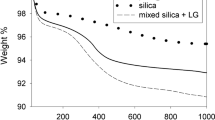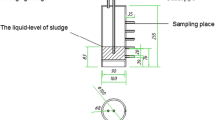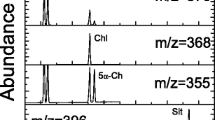Abstract
Lignin serves as one of the most important molecular fossils for tracing Terrestrial Organic Matters (TOMs) in marine environment. Extraction and derivatization of lignin oxidation products (LOPs) are crucial for accurate quantification of lignin in marine sediment. Here we report a modification of the conventional alkaline cupric oxide (CuO) oxidation method, the modification consisting in a solid phase extraction (SPE) and a novel on-column derivatization being employed for better efficiency and reproducibility. In spiking blanks, recoveries with SPE for the LOPs are between 77.84% and 99.57% with relative standard deviations (RSDs) ranging from 0.57% to 8.04% (n=3), while those with traditional liquid-liquid extraction (LLE) are from 44.52% to 86.16% with RSDs being from 0.53% to 13.14% (n=3). Moreover, the reproducibility is greatly improved with SPE, with less solvent consumption and shorter processing time. The average efficiency of on-column derivatization for LOPs is 100.8% ± 0.68%, which is significantly higher than those of in-vial or in-syringe derivatization, thus resulting in still less consumption of derivatizing reagents. Lignin in the surface sediments sampled from the south of Yangtze River estuary, China, was determined with the established method. Recoveries of 72.66% to 85.99% with standard deviation less than 0.01mg/10g dry weight are obtained except for p-hydroxyben-zaldehyde. The lignin content Σ8 (produced from 10 g dry sediment) in the research area is between 0.231 and 0.587 mg. S/V and C/V ratios (1.028 ± 0.433 and 0.192 ± 0.066, respectively) indicate that the TOMs in this region are originated from a mixture of woody and nonwoody angiosperm plants; the high values of (Ad/Al)v suggest that the TOMs has been highly degraded.
Similar content being viewed by others
References
Bianchi, T. S., Mitra, S., and McKee, B. A., 2002. Sources of terrestrially-derived organic carbon in lower mississippi river and louisiana shelf sediments: implications for differential sedimentation and transport at the coastal margin. Marine Chemistry, 77: 211–223.
Clifford, D. J., Carson, D. M., McKinney, D. E., Bortiatynski, J. M., and Hatcher, P. G., 1995. A new rapid technique for the characterization of lignin in vascular plants: thermochemolysis with tetramethylammonium hydroxide (TMAH). Organic Geochemistry, 23: 169–175.
Creighton, R. H. J., Gibbs, R. D., and Hibbert, H., 1944. Studies on lignin and related compounds. lxxv. alkaline nitrobenzene oxidation of plant materials and application to taxonomic classification1. Journal of The American Chemical Society, 66: 32–37.
Fu, T. B., Chen, S., and Jiang, S. C., 1995. Determination of lignin in sediments by gas chromatography. Acta Oceano-logica Sinica, 17: 59–63.
Goñi, M. A., 1992. The use of CuO reaction products for the characterization of organic matter in the marine environment. University of Washington, Seattle, 624pp.
Goñi, M. A., and Hedges, J. I., 1992. Lignin dimers: structures, distribution, and potential geochemical applications. Geochi-mica et Cosmochimica Acta, 56: 4025–4043.
Goñi, M. A., and Montgomery, S., 2000. Alkaline CuO oxidation with a microwave digestion system: lignin analyses of geochemical samples. Analytical Chemistry, 72: 3116–3121.
Goñi, M. A., Ruttenberg, K. C., and Eglinton, T. I., 1997. Sources and contribution of terrigenous organic carbon to surface sediments in the gulf of mexico. Nature, 389: 275–278.
Hartog, N., van Bergen, P. F., de Leeuw, J. W., and Griffioen, J., 2004. Reactivity of organic matter in aquifer sediments: geological and geochemical controls. Geochimica et Cosmochi-mica Acta, 68: 1281–1292.
Hedges, J. I., and Parker, P. L., 1976. Land-derived organic matter in surface sediments from the gulf of mexico. Geoch-imica Et Cosmochimica Acta, 40: 1019–1029.
Hedges, J. I., and Mann, D. C., 1979a. The lignin geochemistry of marine sediments from the southern washington coast. Geochimica Et Cosmochimica Acta, 43: 1809–1818.
Hedges, J. I., and Mann, D. C., 1979b. The characterization of plant tissues by their lignin oxidation products. Geochimica Et Cosmochimica Acta, 43: 1803–1807.
Hedges, J. I., and Ertel, J. R., 1982. Characterization of lignin by gas capillary chromatography of cupric oxide oxidation products. Analytical Chemistry, 54: 174–178.
Hedges, J. I., and Oades, J. M., 1997. Comparative organic geochemistries of soils and marine sediments. Organic Geo-chemistry, 27: 319–361.
Hyodo, F., Tsugeki, N., Azuma, J., Urabe, J., Nakanishi, M., and Wada, E., 2008. Changes in stable isotopes, lignin derived phenols, and fossil pigments in sediments of lake biwa, japan: implications for anthropogenic effects over the last 100 years. Science of The Total Environment, 403: 139–147.
Knapp, D. R., 1979. Handbook of Analytical Derivatization Reactions. John Wiley & Sons Inc., New York, 768pp.
Kögel, I., and Bochter, R., 1985. Characterization of lignin in forest humus layers by high-performance liquid chroma-tography of cupric oxide oxidation products. Soil Biology and Biochemistry, 17: 637–640.
Kuo, L., Louchouarn, P., and Herbert, B. E., 2008. Fate of CuO-derived lignin oxidation products during plant combustion: application to the evaluation of char input to soil organic matter. Organic Geochemistry, 39: 1522–1536.
Li, Q. L., Yuan, D. X., and Chen, M., 2002. Function and application of surrogate and internal standard in environmental sample analysis. Marine Environmental Science, 21: 46–49.
Lima, D. L. D., Duarte, A. C., and Esteves, V. I., 2007. Solid-phase extraction and capillary electrophoresis determination of phenols from soil after alkaline CuO oxidation. Chemos-phere, 69: 561–568.
Louchouarn, P., Opsahl, S., and Benner, R., 2000. Isolation and quantification of dissolved lignin from natural waters using solid-phase extraction and GC/MS. Analytical Chemistry, 72: 2780–2787.
Louchouarn, P., Lucotte, M., Canuel, R., Gagn, J., and Richard, L., 1997. Sources and early diagenesis of lignin and bulk organic matter in the sediments of the lower st. lawrence estuary and the saguenay fjord. Marine Chemistry, 58: 3–26.
Louchouarn, P., Amon, R. M. W., Duan, S., Pondell, C., Seward, S. M., and White, N., 2010. Analysis of lignin-derived phenols in standard reference materials and ocean dissolved organic matter by gas chromatography/tandem mass spectro-metry. Marine Chemistry, 118: 85–97.
Miltner, A., and Emeis, K., 2000. Origin and transport of terrestrial organic matter from the oder lagoon to the arkona basin, southern baltic sea. Organic Geochemistry, 31: 57–66.
Rezende, C. E., Pfeiffer, W. C., Martinelli, L. A., Tsamakis, E., Hedges, J.I., and Keil, R. G., 2010. Lignin phenols used to infer organic matter sources to Sepetiba Bay-Rj, brasil. Estuarine, Coastal and Shelf Science, 87: 479–486.
Shadkami, F., Sithole, B. B., and Helleur, R., 2010. Rapid screening of hardwood and softwood lignin using low temperature thermochemolysis with a gc injection port. Organic Geochemistry, 41: 586–594.
Stevenson, F. J., 1982. Humus chemistry. John Wiley & Sons Inc., New York, 443pp.
Tareq, S. M., Kitagawa, H., and Ohta, K., 2011. Lignin biomarker and isotopic records of paleovegetation and climate changes from lake erhai, southwest china, since 18.5 kabp. Quaternary International, 229: 47–56.
Wysocki, L. A., Filley, T. R., and Bianchi, T. S., 2008. Comparison of two methods for the analysis of lignin in marine sediments: CuO oxidation versus tetramethylammonium hydroxide (TMAH) thermochemolysis. Organic Geochemistry, 39: 1454–1461.
Author information
Authors and Affiliations
Corresponding author
Rights and permissions
About this article
Cite this article
Zhang, T., Li, X., Sun, S. et al. Determination of lignin in marine sediment using alkaline cupric oxide oxidation-solid phase extraction-on-column derivatization-gas chromatography. J. Ocean Univ. China 12, 63–69 (2013). https://doi.org/10.1007/s11802-011-1936-z
Received:
Revised:
Accepted:
Published:
Issue Date:
DOI: https://doi.org/10.1007/s11802-011-1936-z




